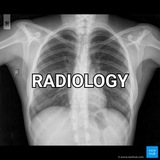Forwarded from Pathology videos & books
Answers
Anonymous Poll
43%
Multiple myeloma
48%
Hyperparathyroidism
11%
Eosinophillic granuloma
7%
Metastasis
👍49
Radiology
Photo
❤9👍7😢1
Radiology
Answers
Achondroplasia is a congenital genetic disorder
resulting in rhizomelic dwarfism (proximal limb
shortening) and is the most common cause of
disproportionate dwarfism
The champagne glass pelvis is a sign
in achondroplasia in which the iliac blades are
flattened, giving rise to a pelvic inlet that
resembles a champagne glass. The acetabular
angles are flattened (horizontal) and the
sacrosciatic notch is small.
resulting in rhizomelic dwarfism (proximal limb
shortening) and is the most common cause of
disproportionate dwarfism
The champagne glass pelvis is a sign
in achondroplasia in which the iliac blades are
flattened, giving rise to a pelvic inlet that
resembles a champagne glass. The acetabular
angles are flattened (horizontal) and the
sacrosciatic notch is small.
👍6❤3
A 7-year-old child presents to
clinic with kyphoscoliosis. Physical
examination of the boy shows that the boy has blue sclera. Radiology of long bones show multiple diaphyseal fractures. Which of the following is not a feature of above disea
clinic with kyphoscoliosis. Physical
examination of the boy shows that the boy has blue sclera. Radiology of long bones show multiple diaphyseal fractures. Which of the following is not a feature of above disea
Anonymous Quiz
24%
A. Type 1 is most lethal
19%
B. Skull may have Wormian bones [
32%
C. Can be associated with autosomal dominant inheritance
25%
D. Battered baby syndrome is the differential diagnosis
👍12👎6❤4
SCIWORA is seen in-
Anonymous Quiz
45%
A. Children
20%
B. Older man
27%
C. Older women
8%
D. Middle aged
❤8👍1
Radiology
SCIWORA is seen in-
SCIWORA, stands for Spinal Cord Injury
Without Obvious Radiolographical
Abnormality, is seen in children due to
increased flexibility of the spine.
◦ Patient will show the signs of damage of
spinal nerve despite the CT and X-ray show
no evidence of fracture.
• Therefore, MRI is needed in such cases to Identify nerve damage.
Without Obvious Radiolographical
Abnormality, is seen in children due to
increased flexibility of the spine.
◦ Patient will show the signs of damage of
spinal nerve despite the CT and X-ray show
no evidence of fracture.
• Therefore, MRI is needed in such cases to Identify nerve damage.
❤13👍7👌3
Radiology
Answers
Luxatio erecta is also known as inferior
dislocation of shoulder.
◦ This is caused due to severe hyperabduction
◦ The radiograph shows head of humerus is
present below glenoid and the shaft is in
abducted position.
dislocation of shoulder.
◦ This is caused due to severe hyperabduction
◦ The radiograph shows head of humerus is
present below glenoid and the shaft is in
abducted position.
❤18👍5
Radiology
Identify the correct statement based on the given radiograph.
Answers of the radiograph.
Anonymous Quiz
26%
A. It commonly leads to cubitus valgus deformity.
40%
B. Damage to the median nerve can cause pointing index finger.
15%
C. Myositis ossificans is one of its acute complication.
20%
D. The most common complication is non union.
👍6❤5
Radiology
Answers of the radiograph.
◦ The above radiograph shows supracondylar fracture of humerus
• Displaced supracondylar fracture of humerus can damage median nerve causing pointing
index sign.
• Its common complication is cubitus varus deformity (Gun stock deformity) due to the
malunion of fractured ends.
◦ Myositis ossificans is a delayed
complication of the fracture.
• Displaced supracondylar fracture of humerus can damage median nerve causing pointing
index sign.
• Its common complication is cubitus varus deformity (Gun stock deformity) due to the
malunion of fractured ends.
◦ Myositis ossificans is a delayed
complication of the fracture.
⚡6👍6
Double PCL sign on MRI is seen in
Anonymous Quiz
18%
A.PCL tear
41%
B. Medial meniscal tear
35%
C. Tear of lateral collateral ligament
6%
D. Fracture patella
❤4🫡2
